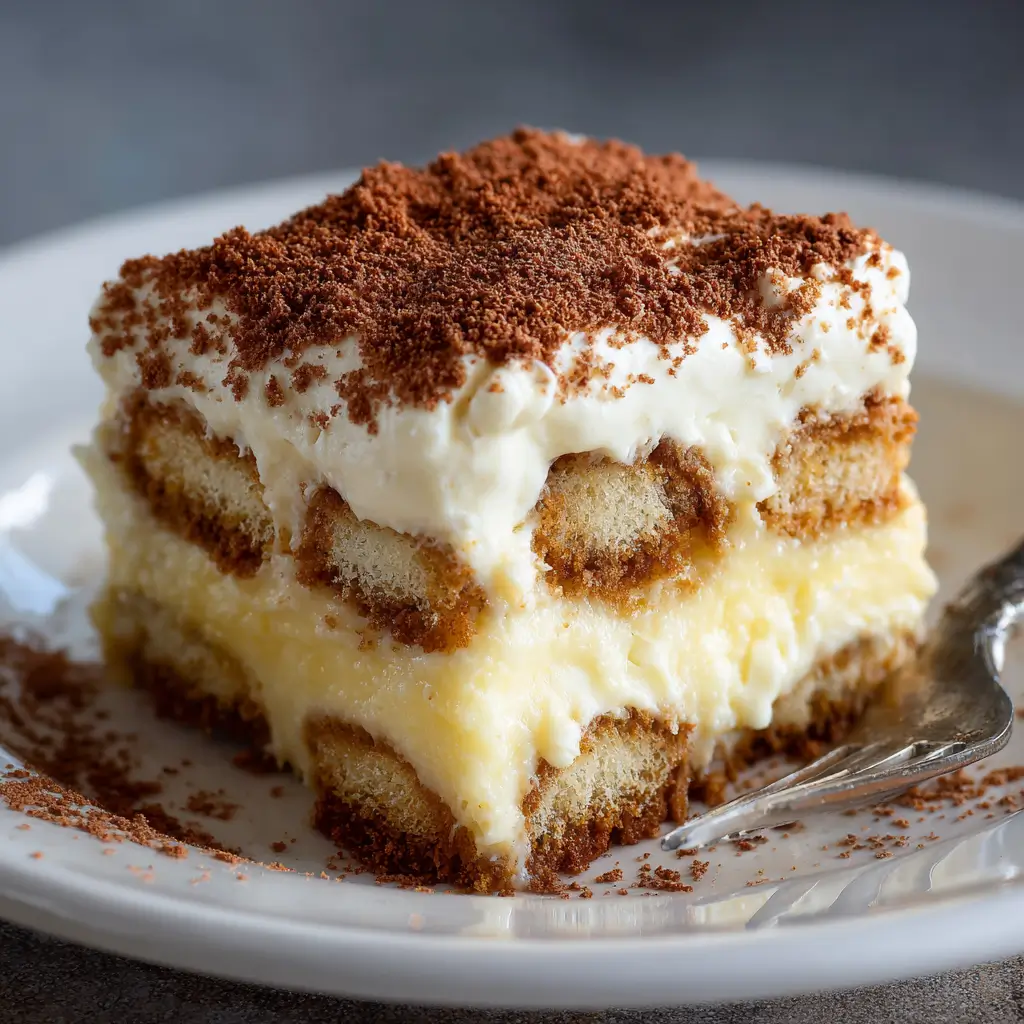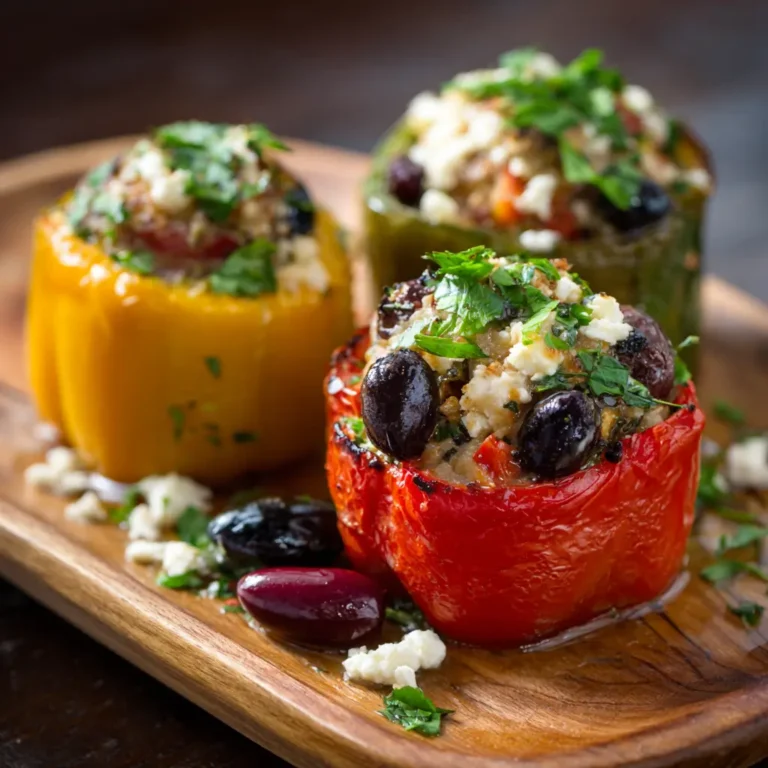Limoncello Tiramisu
Introduction
Welcome to a luxurious twist on a classic Italian dessert — the Limoncello Tiramisu. This delightful fusion brings together the velvety richness of traditional tiramisu and the bright, zesty punch of limoncello, Italy’s beloved lemon liqueur. While classic tiramisu is known for its coffee-soaked ladyfingers and creamy mascarpone layers, this variation swaps out espresso for the citrusy charm of homemade or store-bought limoncello, transforming the dessert into a refreshing, sun-kissed treat perfect for spring and summer gatherings, dinner parties, or as an elegant after-dinner indulgence. Whether you’re a fan of Italian desserts or simply love the tangy taste of lemon, this Limoncello Tiramisu will captivate your senses with its silky texture and vibrant flavor profile.
The History
Tiramisu, which translates to “pick me up” in Italian, originated in the Veneto region of Italy during the 1960s or 70s, though its exact origins remain delightfully debated among food historians. Traditionally made with layers of coffee-dipped ladyfingers, mascarpone cheese, eggs, and cocoa powder, it quickly gained international fame for its rich yet balanced composition. The dessert was originally conceived as an energy-boosting treat, thanks to the caffeine from the espresso and the protein from the eggs and cheese. Over time, chefs and home bakers began experimenting with variations — one of the most popular being fruit-infused versions. Enter Limoncello Tiramisu: a modern reinterpretation that pays homage to Italy’s southern coast, particularly the Amalfi Coast and the island of Capri, where lemons grow large, fragrant, and golden under the Mediterranean sun. Limoncello itself has roots dating back to the early 20th century, traditionally made by steeping lemon zest in alcohol and mixing it with simple syrup. Combining this liqueur with tiramisu is a natural evolution — bringing together two iconic Italian flavors into one unforgettable dessert.
Ingredients Breakdown
The magic of Limoncello Tiramisu lies in the harmony of its ingredients, each playing a crucial role in achieving the perfect balance of creaminess, sweetness, acidity, and aroma. Let’s break them down:
- Ladyfingers (Savoiardi): These light, dry biscuits form the structural base of the dessert. They absorb the limoncello mixture without disintegrating, providing a delicate sponge-like layer.
- Limoncello: The star ingredient. This sweet, potent lemon liqueur infuses every bite with citrus brightness. Choose a high-quality brand or homemade version for the best flavor.
- Fresh Lemons: Used for both zest and juice. The zest adds aromatic oils, while the juice enhances tartness and balances sweetness.
- Mascarpone Cheese: A rich, creamy Italian cheese that forms the luxurious base of the filling. It’s smooth, slightly sweet, and essential for that authentic tiramisu texture.
- Eggs: Typically separated, with yolks enriching the mascarpone mixture and whites sometimes folded in for added fluffiness (though many modern recipes use only yolks for safety and simplicity).
- Sugar: Sweetens the mascarpone cream and balances the tartness of the lemon. Powdered sugar is often preferred for smooth integration.
- Heavy Cream (or Panna da Montare): Whipped and folded into the mascarpone mixture to add volume, lightness, and stability to the layers.
- Vanilla Extract: A subtle note that rounds out the citrus and dairy components.
- Optional Additions: Lemon curd for extra tang, a splash of white wine or vodka to enhance limoncello infusion, or even a dusting of toasted coconut for tropical flair.
Each component works in concert to create a dessert that’s both indulgent and refreshingly light — a true celebration of Italian culinary innovation.
Step-by-Step Recipe
- Prepare the Lemon-Limoncello Soaking Mixture: In a shallow bowl, combine ½ cup of limoncello with the juice of 1 large lemon (about ¼ cup) and 1 tablespoon of lemon zest. Stir well and set aside to let the flavors meld.
- Make the Mascarpone Filling: In a large mixing bowl, beat 4 large egg yolks with ½ cup of granulated sugar using a hand mixer or stand mixer until pale and thick, about 3–5 minutes. Gradually add 16 oz (450g) of mascarpone cheese and mix on low speed until smooth and fully incorporated. Avoid overmixing to prevent curdling.
- Add Flavorings: Stir in 1 teaspoon of vanilla extract and an additional tablespoon of lemon zest for enhanced citrus aroma. Mix gently until uniform.
- Whip the Cream: In a separate bowl, whip 1 ½ cups of cold heavy cream to stiff peaks. Use chilled bowls and beaters for best results.
- Combine Cream and Mascarpone: Gently fold the whipped cream into the mascarpone mixture in two additions, using a spatula. Fold carefully to maintain airiness and achieve a cloud-like consistency.
- Assemble the Layers: Begin assembling in a 9×13 inch glass or ceramic dish. Quickly dip each ladyfinger into the limoncello-lemon mixture — no more than 1–2 seconds per side — to avoid sogginess. Arrange the soaked ladyfingers in a single layer at the bottom of the dish.
- Add First Cream Layer: Spread half of the mascarpone-cream mixture evenly over the ladyfingers using an offset spatula or the back of a spoon.
- Repeat the Layers: Place a second layer of lightly soaked ladyfingers on top, then spread the remaining mascarpone mixture over them.
- Chill and Set: Cover the dish tightly with plastic wrap and refrigerate for at least 6 hours, preferably overnight. This allows the flavors to meld and the structure to firm up.
- Final Garnish: Before serving, dust the top generously with powdered sugar using a fine sieve. Optionally, garnish with lemon slices, curls of lemon zest, fresh berries (like raspberries or blueberries), or edible flowers for an elegant presentation.
Tips
- Dipping Time is Critical: Never soak the ladyfingers like in traditional tiramisu. Due to the liquid nature of limoncello and lemon juice, they absorb faster. A quick dip (1–2 seconds per side) is sufficient to flavor without collapsing the structure.
- Use Fresh Lemons: Always opt for organic lemons when zesting, and juice them right before use for maximum freshness and aroma.
- Quality Matters: Invest in a good bottle of limoncello. If possible, choose one made in Southern Italy (e.g., Sorrento or Capri) for authentic floral-citrus notes.
- Stabilize the Cream: For longer-lasting structure, especially in warm environments, consider adding 1 tablespoon of sifted cornstarch or 1 tsp of instant dissolved vanilla pudding powder to the cream while whipping.
- Egg Safety: If you’re concerned about raw eggs, use pasteurized eggs or substitute the yolk mixture with a cooked zabaglione method: whisk yolks and sugar over a double boiler until thick and safe to consume, then cool before mixing with mascarpone.
- Chill the Dish: Refrigerate the serving dish beforehand to help the dessert set faster and stay cold longer.
- Serve Chilled: Always serve Limoncello Tiramisu cold — straight from the refrigerator — for optimal texture and refreshment.
- Cut Cleanly: Use a sharp knife dipped in hot water and wiped dry between cuts for clean, neat slices.
Variations and Customizations
The beauty of Limoncello Tiramisu lies in its adaptability. Here are several creative twists to personalize your dessert:
- Vegan Version: Substitute mascarpone with cashew cream or vegan mascarpone, use aquafaba (chickpea brine) instead of egg whites, and choose plant-based ladyfingers. Sweeten with agave or maple syrup and use vegan limoncello (some brands are egg-free and dairy-free).
- Gluten-Free: Use certified gluten-free ladyfingers or sponge cake slices. Many brands now offer excellent GF options that hold up well in no-bake desserts.
- Alcohol-Free: Replace limoncello with a non-alcoholic lemon syrup made from lemon juice, zest, sugar, and water. Add a splash of lemon extract for potency.
- Fruit Infusions: Layer in fresh berries such as raspberries, strawberries, or passionfruit pulp between the cream layers for a fruity burst.
- Herbal Notes: Infuse the limoncello mixture with a sprig of fresh mint or basil for a garden-fresh twist.
- Chocolate Drizzle: Add elegance with white chocolate or dark chocolate shavings or a zigzag of melted chocolate on top before serving.
- Lemon Curd Swirl: Introduce swirls of homemade lemon curd into the mascarpone mixture for intensified lemon flavor and visual appeal.
- Individual Servings: Prepare the dessert in martini glasses, mason jars, or parfait cups for charming, portion-controlled servings ideal for parties.
- Sparkling Variation: Use prosecco or sparkling wine mixed with limoncello for a bubbly, celebratory touch.
Health Considerations and Nutritional Value
While undeniably delicious, Limoncello Tiramisu is a rich dessert best enjoyed in moderation. Here’s what you should know:
- Calories: A typical serving (1/12 of a 9×13 pan) contains approximately 350–450 calories, depending on ingredient proportions and additions.
- Fat Content: High in saturated fat due to mascarpone, heavy cream, and egg yolks. One serving may contain 20–30g of fat.
- Sugar: Contains significant added sugar from limoncello, sugar in the filling, and the ladyfingers. A single serving may have 25–35g of sugar.
- Alcohol: Each serving contains about 1–2 tablespoons of limoncello, translating to roughly 3–6% ABV per portion. Most of the alcohol remains uncooked, so it’s not suitable for children, pregnant women, or those avoiding alcohol.
- Protein and Calcium: Provides moderate protein and calcium from eggs and dairy, contributing to satiety and bone health.
- Dietary Modifications: Can be adapted for lower sugar (using sugar substitutes), reduced fat (light mascarpone and cream alternatives), or allergen-free diets with careful substitutions.
- Digestive Impact: The lemon content may trigger acid reflux in sensitive individuals. Consume cautiously if prone to GERD.
Despite its indulgence, the inclusion of real lemon offers vitamin C and antioxidants. As with all desserts, balance is key — pair with a light meal and enjoy mindfully.
Ingredients
- 24–30 ladyfingers (Savoiardi)
- ½ cup (120ml) limoncello liqueur
- Juice of 1 large lemon (approx. ¼ cup)
- 2 tablespoons finely grated lemon zest (from 2–3 organic lemons)
- 4 large egg yolks (preferably pasteurized)
- ½ cup (100g) granulated sugar
- 16 oz (450g) mascarpone cheese, cold
- 1 ½ cups (360ml) heavy whipping cream, cold
- 1 teaspoon pure vanilla extract
- Confectioners’ sugar, for dusting
- Lemon slices or zest curls, for garnish (optional)
- Fresh berries, for decoration (optional)
Directions
- In a flat dish, mix together the limoncello, freshly squeezed lemon juice, and 1 tablespoon of lemon zest. Set aside to infuse for 10 minutes.
- In a medium heatproof bowl, whisk together egg yolks and granulated sugar. Place over a pot of simmering water (double boiler) and whisk continuously for 5–7 minutes until the mixture becomes pale, thick, and reaches 160°F (71°C) for safety. Remove from heat and let cool slightly.
- Transfer the warm yolk mixture to a large mixing bowl. Add the mascarpone cheese and vanilla extract. Beat on low speed until smooth and fully combined. Do not overmix.
- In a separate bowl, whip the cold heavy cream to stiff peaks. Gradually fold the whipped cream into the mascarpone mixture in two batches, using a spatula, until no streaks remain. Stir in the remaining 1 tablespoon of lemon zest.
- Working quickly, dip each ladyfinger into the limoncello mixture for 1–2 seconds per side. Do not oversoak.
- Arrange a layer of soaked ladyfingers in a 9×13 inch dish, breaking pieces as needed to fit gaps.
- Spread half of the mascarpone-cream mixture evenly over the ladyfingers.
- Add a second layer of dipped ladyfingers, followed by the remaining cream mixture. Smooth the top with a spatula.
- Cover with plastic wrap, pressing it directly onto the surface to prevent skin formation. Refrigerate for at least 6 hours, or preferably overnight.
- Before serving, remove plastic wrap and dust the top liberally with powdered sugar using a fine-mesh sieve. Garnish with lemon zest curls, thin lemon slices, or fresh berries.
- Slice with a warm knife and serve chilled.
FAQ
Can I make Limoncello Tiramisu ahead of time?
Yes! This dessert actually improves with time. Make it 1–2 days in advance for deeper flavor integration.
Is raw egg safe in this recipe?
If you’re concerned, use pasteurized eggs or cook the yolks over a double boiler until thickened and safe (160°F). Many commercial mascarpone desserts use raw eggs without issue, but caution is advised for vulnerable populations.
Can I freeze Limoncello Tiramisu?
Not recommended. Freezing can alter the texture of the mascarpone and cause separation. It’s best enjoyed fresh from the fridge.
What if I can’t find limoncello?
You can make a mock version with ½ cup lemon juice, 2 tbsp vodka or neutral spirit, 2 tbsp sugar, and 1 tsp lemon extract. Chill and use as a substitute.
Why are my ladyfingers soggy?
You likely soaked them too long. Dip briefly — just enough to moisten. The alcohol and juice penetrate faster than coffee.
Can I use lemon yogurt or cream cheese instead of mascarpone?
Mascarpone is essential for authentic texture. Cream cheese is too tangy and dense; lemon yogurt will make the dessert watery. Stick to mascarpone for best results.
How long does it last in the fridge?
Up to 4 days when tightly covered. However, quality declines after day 3 as the ladyfingers soften further.
Can I add coffee for a hybrid version?
Absolutely! Some bakers enjoy a “Lemon-Coffee Tiramisu” by splitting the soaking liquid — half coffee, half limoncello — for a bold yet bright profile.
Summary
Limoncello Tiramisu reimagines a timeless Italian classic with a sunny, citrus-forward twist that delights the palate and elevates any occasion. Creamy mascarpone, zesty lemon, and aromatic limoncello come together in a no-bake masterpiece that’s as beautiful as it is delicious.






